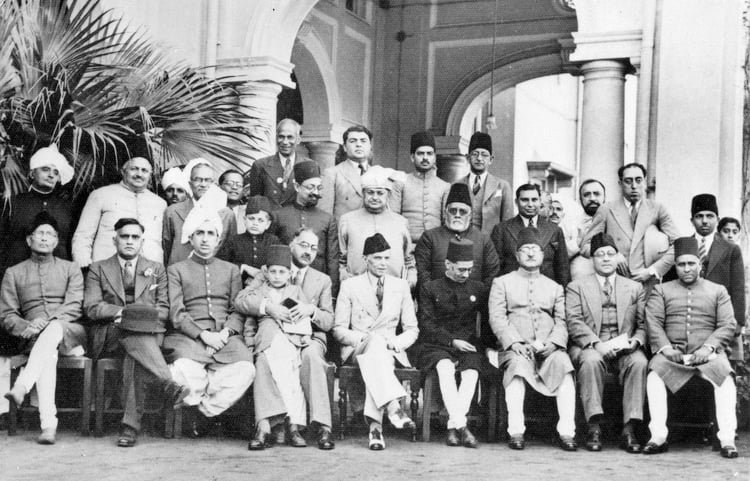“When the British raj finally endured, jinnah, soon-to-before governor-general of the dominion of Pakistan, outlined his Vision of Pakistan in an adDress to the constituent assemblies”, said Quaid-e-AaNnnah on 11 Jinnah August 1947.
In 1947, Amidst an Emotional Storm of Belief and Incredulation, Hope and Despair, Pakistan was carved out of British India as a homeland for south asia’s Muslims. It was a problem to a plan.
But what began as a dream of a progressive, inclusive, and Modern Islamic Welfare State Quickly Became A Struggle To Survive Amid Internal Crises, Power Clicuum, and Institutional Overreach.
A One-Man Nation:
Quaid-e-Azam Muhammad Ali Jinnah
Few Leaders have reshaped history like Muhammad Ali Jinnah. Leonard Mosley Called Pakistan’s Birth a “One-Man Achievement.” Historian Stanley Wolpert Was Even More Direct:
“FEW INDIVIDULS Significantly Alter The Course Of History. Fewer Still Modify The Map of the World.
Yet therein lay the seeds of vulnerability. Pakistan’s motion, dominated so singularly by Jinnah, never Developed a Broader Base of Mature Leadership. When Jinnah Passed Away Justice 13 months after Independence, Pakistan was Thrust into uncertai. Beverly nichols, a British Journalist, Had Warned Prophetically:
“If Gandhi goes, there is always nehru, or Patel, or Rajagopalaachari … but if jinnah goes, who is there?”
The Answer, Tragically, was no one.

Liaquat Ali Khan Lawyer, Politician and STATESMAN WHO SERVED AS The first prime minister of pakistan from 1947 to 1951
Liaquat Ali Khan, Jinnah’s Close Aide, Tried to Fill the Void. While he is rose in status, he acquired the nover wield the authority or vision of his predecessor. The political capital of the New Nation was shockingly shallow.
A party without Roots:

All-India Muslim League (1947 to 1958)
The Muslim League, which had Steered Pakistan Movement, was more of a mass mobileization platform than a structural party. It has fee grassroots Cadres, no ideological cohesion, and latetle capacity to function in government.
There are ever voices with the League proposing its dissolution post-endependence to Allow New Political Alignments to Emerge-Natural Parties with distinct ideologies and regional represents. But those proposals were shot down. The result was a party unable to transition from agitation to administration.
Many of its senior filings were Deeply Provincial in their reality, often rivals in their home territories. The League was quickly overwhelmed by the Civil and Military Institutions that Adapted swiftly to their new roles.
Worship Still, The League’s Post-Independence Leadership Ignored Key Regional Leaders-Politicians Who May For Supported The Pakistan Movement But Had Strong Local Legitimacy. These include Khan Abdul Ghaffar Khan, Abdul Samad Achakzai, GM SYED, and Ghous Baksh Bizenjo – Figures Who has HEVE HELLPED CEMENT A FEDAL, INCLUSIVE, AND PLURALIC VINION FOR PAKISTAN.
Marginalising Voices of Dissent:
Jinnah Had Had Offered Reconciliation. He proposed Dr. Khan Sahib – Ghaffar Khan’s Brother –as Governor of the Nwfp. But such overstures were frustrated. The League Preferred To Marginalize Rather Than Than Engage.

AK Fazlul Haq: One of the best-Loved Leaders of Bengal
Even with its owners fold, lead for stood for provincial autonomy or cioderties were gradually shown the door. Men like suhrawardy, fazlul haq, Maulana Bhashani, and iftikharuddin were one at the heart of the League. Their alienation weakened the Nascent Democratic Order Further.
Rise of the Bureaucratic-Military State:
As the politicalians faaltered, Bureaucrats stepped in. Steeped in Colonial Experience, Civil Servants Ran Pakistan Much Like the Raj Had – Centralized, Autocratic, and Hierarchical. When General Ayub Khan Became Army Chief, a Civil-Military oligarchy began to take shape.

Military Leader and Politician Ayub Khan
Partition Had Left Pakistan Insecure. The war over Kashmir Development was soon aligned not with social uplift but with Military Strength. Welfare, Democracy, and Pluralism were quietly sidelined.
The US Became A Convenient Partner in this arrangment. Liaquat ali Khan’s early trip to washington was a “spiritual bridge,” but his shift ideas towards Non-alignment Later isleted. By 1951, he was assassinated under mysterious circumstans. The Rawalpindi Conspiracy Case and sidelining of Civilian Leaders Showed clearly out there so that Real Power Lay.
A Divided Legacy:
Historians have extensively chronicled Pakistan’s Authoritarian Drift. But long before them, writers and artists capture the soul of a national in Turmoyil.
Saadat Hasan Manto Laid Bare The Hypocrisy And Trauma of Partition. Faiz Ahmed Faiz and Noon Meem Rashid Gave Voice to the display and the betrayed. Ahmad Nadeem Qasmi Sketched The Dilemmas Of A Divided People.
These were not just poets or writers —they were council keepers. Shouldn’t they too be remebered as founding fathers, along with the politicalians?
A Future Yet to be written:
Pakistan’s Story CREATED IN THE NAME OF UNITY, YET MARKED BY DIVISION. What might have been a federal, democratic islamic welfare state became a centralized, security-obesitation entity.
Yet history is not destiny. The voices that were once gnored –regional leaders, inletules, artists – stop echo in the Country’s Cultural and Political Landscape. The question remains: will they ever be truly Heard?
Pakistan’s Journey, like that of all notes, is still unfolding. But to chart a better future, we must first understand where the road turned – and why.

